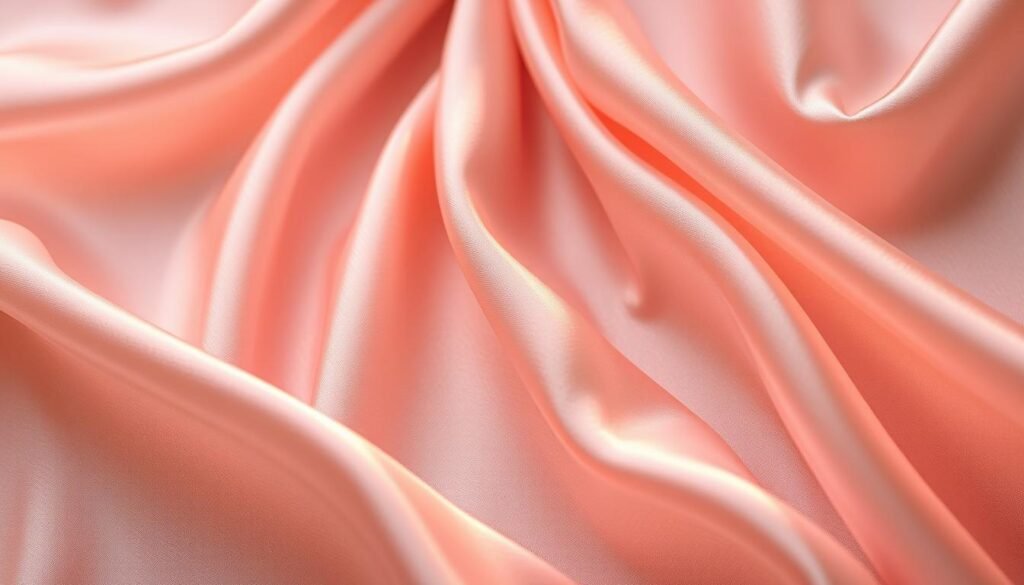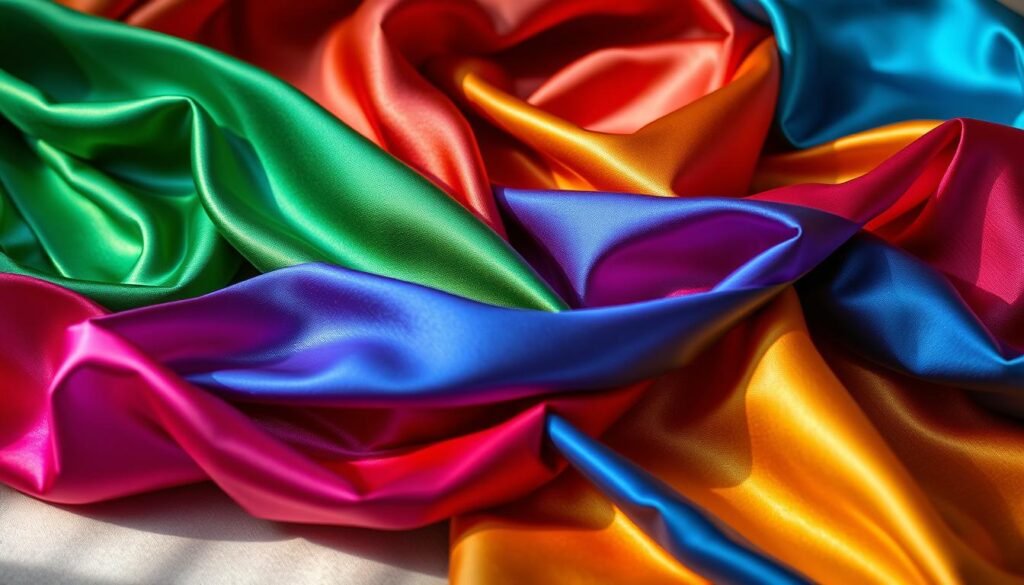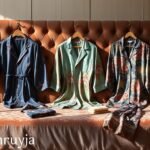Silk has been a luxury for thousands of years1. It started in ancient China around the 27th century BC2. People worked hard to make and protect it for a long time2. But what makes silk special? Let’s find out why this material is so loved and valuable.
Key Takeaways
- Silk is a natural protein fiber, mainly made of fibroin. It’s known for its shine and softness1.
- China was the only one making silk for a long time. This led to the Silk Road trade routes1.
- Silk is famous for its natural shine, smooth feel, strength, stretch, and keeping warm or cool1.
- Silk lets air in and keeps the body temperature right. It’s also safe for people with allergies1.
- Silk breaks down easily, making it good for the planet1.
What is Silk Fabric?
Silk is a natural protein fiber known for its shiny look, soft feel, and luxury. Silk fabric is mostly made of fibroin, a protein from silkworms. It has been made since ancient China, around the 27th century BC3.
The Chinese empress Hsi-Ling-Shi is said to have started silk production and weaving3.
Definition and Composition
Silk is a natural fiber loved for its top-notch qualities. It’s made of the protein fibroin, which makes it shiny, strong, and soft4. Silkworms are raised and their cocoons are used to make silk4.
Origins and History
Silk started in ancient China and quickly became very valuable3. Only Chinese emperors could use it. Silk spread to places like the Middle East, Europe, and North Africa, becoming a key luxury item3.
This led to the Silk Road, a network of trade routes that shared goods, ideas, and cultures3.
Silk was big in Japan’s economy from 1850 to 1930, making up 20% to 40% of exports3. Synthetic materials like Nylon hurt the Japanese silk industry in World War II3. Now, China is the top silk exporter3.
Types of Silk Fabric
Silk is a luxurious fabric with many types, each with its own look and use. From the famous mulberry silk to the textured tussah silk, silk offers many options for fashion lovers and those who decorate homes5.
Mulberry Silk
Mulberry silk comes from silkworms that eat only mulberry leaves. It’s the top quality silk6. This fabric is known for being smooth, soft, and light. It’s often used in high-end clothes and accessories.
Tussah Silk (or Tusser Silk)
Tussah silk comes from wild silkworms that eat different foods. They are not raised in a controlled place. So, tussah silk looks more textured and has an earthy color5.
Charmeuse Silk
Charmeuse silk is made from different silks, including mulberry. It shines on one side and is matte on the other. This makes it very interesting to look at5.
Dupioni Silk
Dupioni silk is known for its slubs, or thicker parts in the yarn. These make it feel a bit rough but also very shiny5. It’s used in formal clothes, furniture, and for decorating homes.
Habotai Silk
Habotai silk is from Japan and is often used for linings. It’s very light, soft, and shiny. This makes it great for many kinds of clothes and accessories5.
Chiffon Silk
Chiffon silk is very light and almost see-through. It feels a bit rough and is perfect for feminine, flowing styles5.
Crepe de Chine
Crepe de Chine is a soft silk with a crinkled look and a gentle shine. It looks delicate and elegant5.
These different silks are loved for their special qualities. They are used in many things, like wedding dresses, formal gowns, evening wear, lingerie, and home furnishings5.
“Silk, with its varied manufacturing techniques and sources, has given rise to several distinct types, each with its own allure and application.”
Is Silk a Fabric? Exploring Its Characteristics
Silk is indeed a fabric, made from a natural protein fiber. It can be woven or knitted into different materials7. Silk stands out because of its natural sheen, smooth feel, and many other qualities.
It has a unique structure that makes it shimmer and glow7. Silk is very soft and comfortable. It also keeps its shape well and is breathable7. These features make silk a luxury fabric loved for centuries.
The history of silk goes way back7. China has evidence of silk making from 3500 BC7. Countries like Thailand, Cambodia, India, and China are famous for their silk7. Silk also reached Italy and Spain, making them wealthy and important places7.
Now, scientists are looking into synthetic silk, like spider silk, which is very strong7. But, natural silk is still the most valued for its beauty and special qualities.

In conclusion, silk is a fabric with unique qualities that make it very special. From its ancient roots to today, silk has always been admired. It shows the beauty and versatility of this amazing natural fiber.
Characteristics and Advantages of Silk Fabric
Silk comes from silkworm cocoons. It’s known for its special qualities. These make it a top choice in fashion and design.
Natural Sheen
Silk shines because of its natural sheen. This shine comes from how silk’s molecules work with light8.
Smooth Texture
Silk feels smooth and soft. It’s because of its fine fibers. This makes it very comfortable and elegant.
Strength and Elasticity
Silk looks delicate but is very strong. In fact, it’s stronger than steel in some ways8. It also stretches and goes back to its original shape easily.
Insulation and Breathability
Silk is great at keeping you warm or cool. It’s a natural insulator and breathable. This means it keeps you comfortable in different weather8.
Silk’s many features make it special. Its shine, softness, strength, stretch, insulation, and breathability make it valuable in fashion and home decor.
Uses of Silk Fabric
Silk is loved for its luxury and unique feel. It’s used in clothes, home decor, and furniture9. Silk adds elegance and sophistication to any space, from curtains to throw pillows.
Upholstery
Silk makes furniture look refined and luxurious9. It’s used on seats, headboards, and more. Silk needs special treatments to last longer but looks amazing.
Curtains and Drapes
Silk can look soft, sheer, or luxurious9. It’s perfect for curtains and drapes. Silk’s flowing look and natural shine make rooms look stunning.
Throw Pillows and Cushions
Silk is great for throw pillows and cushions9. It adds luxury to any room. Silk fits many styles, making rooms look better.
“Silk’s ability to provide a soft, sheer, or opulent look, depending on the weight and weave of the fabric, has made it a favored option for curtains and drapes.”
Silk Fabric Colors
Silk comes in many colors, from the natural tones of the silkworm to bright shades from dyeing10. In its natural state, silk is creamy white to soft beige or light gold10. The color depends on the silkworm type and what it eats10. This natural beauty makes silk fabrics elegant and true to their origins.
Dyed Silk: Unlocking a Kaleidoscope of Hues
By dyeing, silk can turn into many colors, from soft pastels to deep jewel tones10. This makes silk popular for fashion and home decor. It’s used in everything from fancy clothes to luxury home items.
Dye Fastness: Ensuring Long-Lasting Brilliance
How long silk colors last is important11. The dye’s resistance to fading is key. With good dyes and after-dye treatments, silk colors stay bright and beautiful. This makes silk a great choice for many uses.
| Silk Fabric Type | Characteristic |
|---|---|
| Mulberry Silk | The most common and widely used type of silk11 |
| Tussah Silk (or Tusser Silk) | Has a unique texture and a slightly rougher feel compared to mulberry silk11 |
| Charmeuse Silk | A lightweight fabric with a glossy front and a matte back, often used in luxurious evening gowns and lingerie11 |
| Dupioni Silk | Characterized by its slubbed texture and is favored for its unique aesthetic in formal wear and home furnishings11 |
| Silk Duchesse Satin | A specialty satin characterized by its greater weight and stiffness, popular for wedding dresses and formal gowns10 |
| Silk Crêpe de Chine | A supple fabric used for a variety of applications, comfortable and easy to care for10 |
| Silk Crêpe Georgette | A medium-weight fabric that drapes well, suitable for summer frocks, blouses, and scarves10 |
| Silk Marocain | A heavy, luxurious crêpe fabric with a matte sheen, ideal for formal wear and wedding dresses10 |
Silk goes from natural tones to bright colors through dyeing. It offers a wide range of colors for different styles and designs. Explore the endless possibilities of silk fabric and bring your ideas to life.

How to Clean Silk Fabric
Cleaning silk fabric needs gentle care to keep its luxurious look and feel. Always check the care label before cleaning12. For hand washing, use cool water and a mild detergent. Gently swish the fabric and rinse well to protect the delicate fibers12.
Be very careful with silk when it’s wet because the fibers can easily get damaged12. Lay silk items flat to dry on a towel, away from sunlight to prevent damage12. When ironing silk, use a low ‘silk’ setting and a thin cotton cloth to protect it12.
If an item is labeled ‘dry clean only’ or is a complex silk garment, get a professional cleaner12. Keep silk in a cool, dry place, like garment bags, to keep it in top condition12.
- Most silk fabrics can be spot-cleaned with lukewarm water, lemon juice, or mild vinegar13.
- Most tough stains on silk can be removed with a mix of equal parts water, mild ammonia, or alcohol13.
- Use a solution with 1/4 cup (50 ml) of white vinegar to rinse silk items. This helps remove soap, restore shine, and soften the fabric13.
For silk upholstery, lampshades, and ties, use specific cleaning methods to keep them looking good13. Always test a small area first to see if the dye will run or bleed12.
“Silk is considered one of the strongest fabrics on Earth, historically used for armor and bulletproofing.”14
To make silk garments last longer, follow the right cleaning steps and avoid harsh chemicals or extreme temperatures14. Natural cleaners like distilled white vinegar can remove soap residue, stop alkali damage, and brighten the silk14.
By using these gentle cleaning methods and taking good care of silk, your silk items will stay luxurious and last a long time121314.
Silk Fabric Production
The process of making silk fabric has stayed the same for thousands of years15. Silkworm breeders take care of the silkworms and then harvest their cocoons. They then unravel and twist the silk threads into yarn15. After that, they might dye, bleach, or stiffen the yarn to get the look they want15.
Manufacturing Process
Making silk is a complex process. First, silkworms are given the right food and environment to make the best silk15. Then, the cocoons are heated to stop the worms from coming out. The silk threads are twisted together to make yarn15. Weavers use different techniques like plain and satin weaves to make patterns and textures15.
Major Producing Countries
Silk has a long history, starting in China around 2700 BCE16. Today, China and India make most of the world’s silk16. Uzbekistan and Thailand also produce a lot of silk, showing its global importance16.
| Country | Silk Production (Metric Tonnes) |
|---|---|
| China | 146,000 |
| India | 28,708 |
| Uzbekistan | 3,000 |
| Thailand | 1,000 |
“Silk reflects a blend of art and science in its production from cocoon to cloth.”16
Cost and Availability of Silk Fabric
Silk fabric is quite pricey, with Chinese silk costing between $50 and $55 per kilogram17. This high price comes from the hard work needed to make silk and the challenges in making more of it17. Yet, a kilogram of raw silk can make many garments or home items, making it a good choice for those wanting luxury and quality17.
The high cost of silk comes from how hard it is to make. This includes raising silkworms and taking out and weaving the fibers by hand17. Also, getting silk from where it’s made to where it’s sold adds to the cost17. But, silk’s special qualities like its shine, smooth feel, strength, and ability to breathe make it popular worldwide18.
For those who think silk is too expensive, there are cheaper and kinder options. These include organic silk and peace silk, where silkworms get to leave their cocoons17. Wild silk types like Tussah silk are also cheaper and have a special feel and look17.
The price and availability of silk depend on many things. These include the type of silk, how it’s made, and if it’s made in a way that’s good for the planet17. By choosing a trusted silk, people can get quality silk products. They also support the silk industry’s growth in a way that’s good for the planet17.
“Silk’s higher price tag is a reflection of its exceptional quality and the intricate process involved in its production. For those seeking the unmatched luxury and elegance of this natural fiber, the investment is well worth it.”
Conclusion
Silk is a truly amazing fabric that has wowed people for centuries19. It started in ancient China and is now loved all over the world20. Silk is known for its natural shine, smooth feel, strength, stretchiness, and breathability19.
China makes and sends out the most silk in the world20. This has changed global trade and culture for a long time20. Silk is expensive but its unique qualities and lasting beauty make it very popular20.
Silk is very important in fashion, home decor, and more19. It’s versatile, long-lasting, and elegant19. Exploring silk shows us its deep history, detailed making, and lasting charm.
FAQ
What is silk fabric?
Silk is a luxurious natural fiber known for its shine and softness. It’s made of a protein called fibroin. This makes it very soft and shiny.
What is the history of silk?
Silk’s history goes back to ancient China, around the 27th century BC. China kept its silk secrets for many years. This made silk a big deal and led to the Silk Road.
What are the different types of silk fabric?
There are many types of silk fabric. These include mulberry silk, tussah silk, charmeuse, dupioni silk, habotai silk, chiffon silk, and crepe de Chine.
What are the characteristics of silk fabric?
Silk has a special structure that makes it shine. It’s smooth, strong, stretchy, keeps warmth, and lets air through. This makes it very special.
What are the advantages of silk fabric?
Silk is loved for its shine, smooth feel, strength, stretch, warmth, and breathability. These qualities make it perfect for many uses.
How is silk fabric used?
Silk is used in many things like clothes, furniture covers, curtains, and pillows. It adds beauty and class to these items.
What colors can silk fabric come in?
Silk comes in many colors, from its natural shades to bright ones. The color’s lasting power is important.
How do you clean silk fabric?
To clean silk, wash it by hand in cold water with a gentle detergent. Let it air dry and iron it on a low ‘silk’ setting. For tricky items, get a pro to do it.
How is silk fabric produced?
Making silk is similar to how it was done long ago. It involves taking silk threads from cocoons and twisting them together. China makes the most silk in the world.
How expensive is silk fabric?
Silk is pricey because making it is hard work and hard to make a lot of it. Right now, silk from China costs between and per kilogram.




